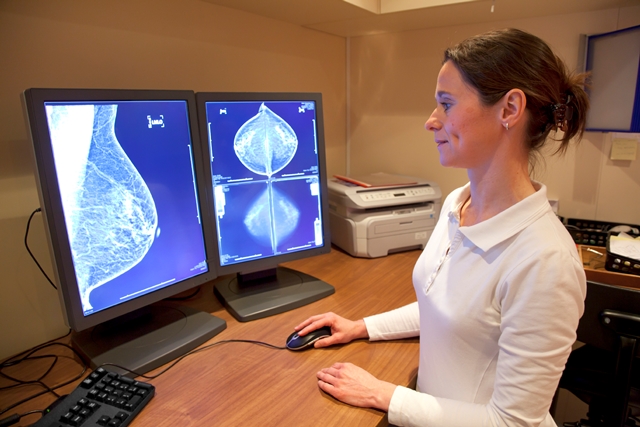If you’ve heard some of the buzz surrounding 3-D mammography recently and would like to learn more, Toni Carle, nurse manager of St. Elizabeth Women’s Wellness, would like to help.
Since the Food and Drug Administration approved the new technology in 2011, women’s wellness centers across the country ““ St. Elizabeth included ““ have been adding 3-D mammography machines to their breast cancer arsenal to help with early detection.
If you think of mammography as taking a picture of a book, Carle said, 3-D mammography is like opening the book so you can see all of the pages.
“With 3-D mammography, healthcare providers can see each layer of breast tissue,” she said. “It’s taking pictures in slices, which helps locate breast cancers earlier and also decreases the risk of a false positive ““ or, from a patient’s perspective ““ from a callback for additional screening.”
Currently, St. Elizabeth has five 3-D mammography machines ““ at its Edgewood, Florence, Ft. Thomas and Grant County locations, as well as its mobile mammography van ““ with plans to add additional machines in 2016 to its Edgewood and Covington locations.
Carle’s ultimate goal is to replace all of St. Elizabeth’s 2-D mammography machines with 3-D machines.
That’s not to say that the 2-D mammography machines are no longer able to do the job of early breast cancer detection.
“When you have new technology, people often think it’s the latest and greatest and the old technology isn’t as good,” Carle said. “That’s not true. This is just another tool that can be used on top of the already phenomenal 2-D mammography technology already out there.”
The difference, Carle continued, is that when 3-D mammography first came on the scene a few years ago, the healthcare industry viewed it as only beneficial to women who were at high risk for breast cancer, such as those who have had previous breast surgery, those who have felt a lump, or for those patients who have thick or dense breast tissue.
Today, the understanding is that 3-D mammography can help everyone.
“We decrease the worry in patients that there might be something wrong when we can see more at the first screening,” Carle said. “It decreases the risk that we have to bring you back in.”
One caveat is that most insurance companies still aren’t buying into the cost-savings benefits 3-D mammography provides.
“Decreasing callbacks is a cost savings to women and to healthcare,” Carle said.
Right now, 3-D mammography typically costs $60 to $100 out of pocket for patients, in addition to the cost of the mammogram, although Carle hopes more insurance companies will decide to cover it in the coming years.
Those women who would prefer 3-D mammography even when their healthcare providers don’t deem it necessary ““ and who don’t mind the additional cost ““ only have to ask for it at St. Elizabeth, Carle said. Especially because there are no additional risks associated with 3-D mammography.
“It’s the same compression, the same amount of time, the same type of machine,” Carle said. “The exposure to X-ray energy is still very low, too, so there shouldn’t be any concerns about radiation exposure.”
If you’re wondering if 3-D mammography is right for you, talk to your provider.
“Have a conversation with him or her to review your risk and determine when the right time is to get a mammogram,” Carle said. “Your provider will help you come up with a plan for mammography.”

